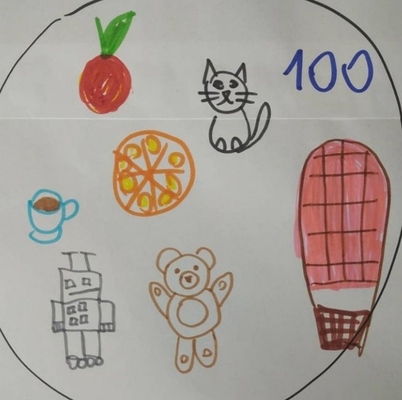
This started as an activity for the CLIL lesson devoted to space and Yuri Gagarin but after I published it on Instagram, one of my friends suggested that it might be a great idea for the end-of-year revision activity. And it is that, indeed. Thank you, Rory!:-) Hence this post.
Ingredients
- An A1 piece of paper although, to be perfectly honest with you, it never is that. Every time I have made any murals (and that’s what this activity really is), the preparations started with a pile of A3 sheets of paper, a roll of scotch or a glue stick. It is easier and faster (no shopping trips) and more adaptable (because the teacher is in charge and the poster can be made bigger or smaller, depending on the size of the group or the theme of the project).
- Creative materials of your choice – pencils, markers, finger paints or watercolours. This time we used markers, in my opinion better suited to the age of the kids and the task.
- A place where all the students can draw simultaneously. In my classroom, we use the space in which we normally do the movement activities because we have a big carpet there and it is always a lovely variation to our everyday routine, both for the little kids or the teenagers that like visiting another classroom from time to time. A big conference table or a set of desks put together will be a great solution, too.
- A decision as regards what language, vocabulary and structures, you are going to focus on in the task. In the original task, we created our planets with all our favourite things, our favourite number, colour, food, drink, animal, transport etc.
- It is necessary to stage the activity carefully. The kids sit down on the floor around the poster, the teacher draws the sun in the centre and counts the kids and then draws one planet for each child around the sun. In the first step, each child chooses a marker and writes their name. Then the teacher ‘dictates’ the first topic and the kids draw it and say what they are drawing. In my classes, we use the song for that ‘What’s your favourite colour?‘ by Super Simple Songs and its variations because it offers the question – answer set (‘What’s your favourite…?’ ‘I like….‘). For some kids it is necessary to sing, some are better prepared to respond to questions without the support of the music. The teacher waits for everyone to finish each stage and the fast finishers can be encouraged to draw more than one item, to look at other students’ drawing, react to them (‘Do you like…?’) etc.
- Round-up: If there is time, the students stand in a circle around the poster, first at their own planet and then, on ‘1..2..3! Let’s fly!‘, they move one planet to the left. Everyone reacts to what they can see on the new planet, for example ‘I like…‘ This stage can be repeated a few times, depending on the time available. Afterwards, the poster is displayed on the wall. It can also be used as part of the presentation for the parents in the following lesson.

Why we love it
- First and foremost, it is a great project for the whole group and it really does contribute to building the community and that is because of the fact that we all sit around one big piece of paper and because of the concept of this activity – a solar system of which all the students and the teacher are a part.
- It might be especially suited as the first project work for a pre-school group as everyone has a chance to contribute to the project but it is automatically clear that no one can take the final product home, as first of all, from the very beginning it is obvious that there is only one copy, that it is too big and that all the planets stay a part of the system and cannot be separated. Frequently, this issue can be the biggest problem with the project work for the youngest of students as they become attached to their creations and the first question they ask is ‘Anka, but can we take it home?’. Not this time.
- The activity itself in its original version is very flexible as its timing will depend on how long the children are interested. Perhaps only three elements will be included, perhaps ten. The format of the activity also helps with staging as the children do not know what is to come and will not start going ahead of the group.
- The song format helps to encourage the kids to actually produce the language, especially that in our case we used this question-answer set beforehand so at the time of this particular lesson, the children were already used to it and used to responding to it.
- It can be used with all age groups and levels as the language content can easily be adapted either to more complex ways of discussing favourite things, drawing their own planets to practise the vocabulary of the natural world (with a more extensive presentation at the end of the project), creating a planet which is a symbolic representation of each student. For the older students, the planets can be filled in with words, rather than with images.
Happy teaching!
2 thoughts on “Crumbs #18: Our Solar System. A perfect group project work for early years. Perhaps)”